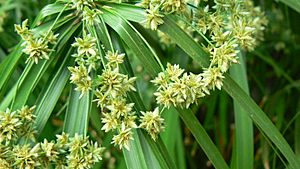Umbrella flat-sedge facts for kids
Quick facts for kids Umbrella flat-sedge |
|
|---|---|
 |
|
| Scientific classification | |
| Genus: |
Cyperus
|
| Species: |
alterniflorus
|
The umbrella flat-sedge (scientific name: Cyperus alterniflorus) is a type of plant called a sedge. It belongs to the Cyperaceae family, which includes many grass-like plants. This plant naturally grows in Australia.
What is the Umbrella Flat-Sedge?
The umbrella flat-sedge is a plant that lives for many years. It grows in a strong, clumpy shape, like a small bush. This plant can reach a height of about 0.3 to 2 meters (1 to 6.5 feet).
How Does It Look?
This sedge has a short, thick underground stem called a rhizome. This rhizome helps the plant spread. Its main stems, called culms, are triangular and can be smooth or slightly rough. These culms grow to be about 0.4 to 1.4 meters (1.3 to 4.6 feet) long and about 5 centimeters (2 inches) thick.
The leaves of the umbrella flat-sedge are usually longer than its stems. They have clear bumps or sections and are about 12 millimeters (0.5 inches) wide.
The plant produces flowers between June and October. These flowers are yellow-green to brown. After the flowers, the plant forms small, three-sided seeds called nuts. These nuts are pale red-brown to dark brown. They are narrow and oval-shaped, measuring about 1.6 to 2.3 millimeters (0.06 to 0.09 inches) long and 0.5 to 0.7 millimeters (0.02 to 0.03 inches) wide.
Where Does It Grow?
In Western Australia, you can find the umbrella flat-sedge near creeks and swamps. It grows in sandy-clay soils in the Mid West, Wheatbelt, and Goldfields-Esperance areas. This plant also grows in inland parts of New South Wales, Queensland, and South Australia.

